中职英语模块1Unit7全单元教案设计
- 格式:doc
- 大小:24.42 KB
- 文档页数:14
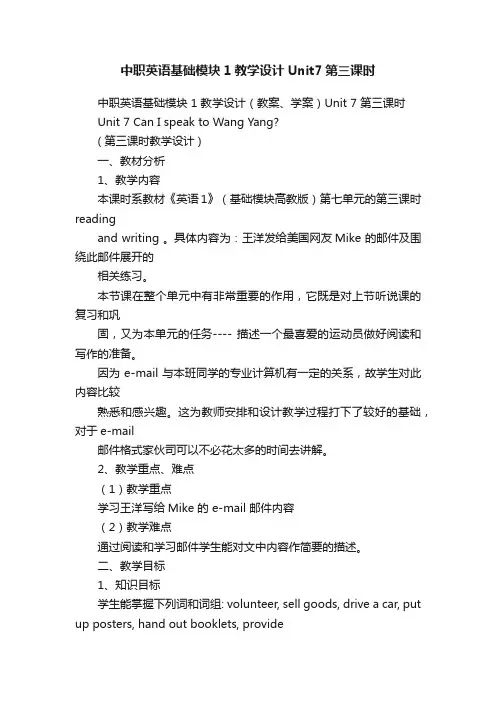
中职英语基础模块1教学设计Unit7第三课时中职英语基础模块 1 教学设计(教案、学案)Unit 7 第三课时Unit 7 Can I speak to Wang Yang?( 第三课时教学设计 )一、教材分析1、教学内容本课时系教材《英语1》(基础模块高教版)第七单元的第三课时readingand writing 。
具体内容为:王洋发给美国网友Mike 的邮件及围绕此邮件展开的相关练习。
本节课在整个单元中有非常重要的作用,它既是对上节听说课的复习和巩固,又为本单元的任务---- 描述一个最喜爱的运动员做好阅读和写作的准备。
因为 e-mail 与本班同学的专业计算机有一定的关系,故学生对此内容比较熟悉和感兴趣。
这为教师安排和设计教学过程打下了较好的基础,对于e-mail邮件格式家伙司可以不必花太多的时间去讲解。
2、教学重点、难点(1)教学重点学习王洋写给Mike 的 e-mail 邮件内容(2)教学难点通过阅读和学习邮件学生能对文中内容作简要的描述。
二、教学目标1、知识目标学生能掌握下列词和词组: volunteer, sell goods, drive a car, put up posters, hand out booklets, providesth. for sb., place flowers, be glad to do, more and more, look forward to2、能力目标习的练,解e-mail 的具体内容—担任奥运志愿者的工作,并通过具体活动完成课文相关通过阅读学生能理从而提高阅读和写作能力3、情感目标鼓励学生通过e-mail 的往来,加深彼此的了解和友谊三、教学步骤Step One Warm up 6 ’1. Teach new word “ volunteer ”Show a red cap of a volunteer.T: What ’ s this?S: ?T: If you wear this cap, what are you?S: ? .T: Do you work as an volunteer?S: ?T: What kind of work do you do as a volunteer?S: ? .T: Here are some work, can you match?2. Match the phrases and the picturesShow some pictures on the screen. They are about: sell goods, drive a car, put up posters, hand out booklets, play volleyball, play the piano and write e-mailWhen students are doing it, teacher asks them to tell the Chinese meaning.设计意图:学校里有青年志愿者服务队,通过志愿者小红帽的展示来学习单词volunteer 学生会觉得印象比较深;通过图片对e-mail 中的词组进行学习为课文学习做铺垫。

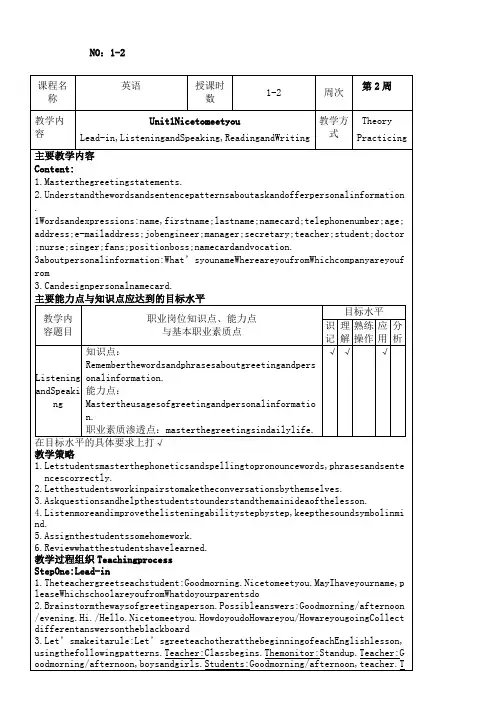
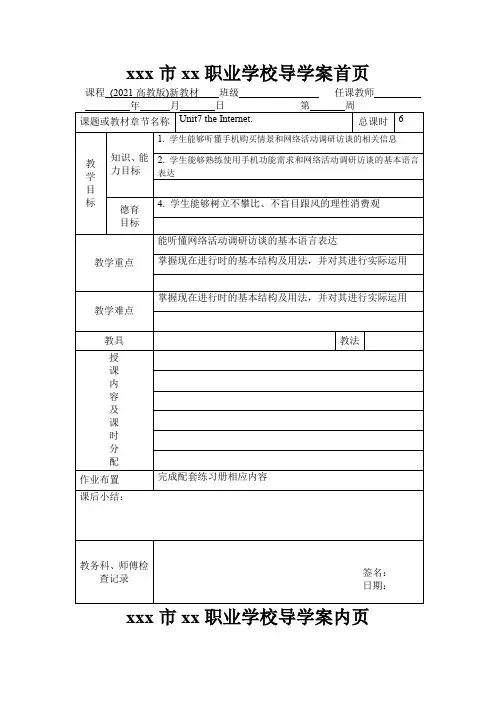
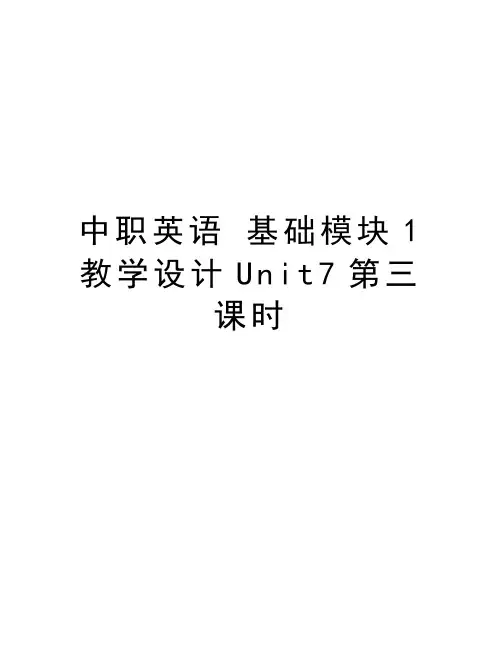
中职英语基础模块1教学设计U n i t7第三课时中职英语基础模块1 教学设计(教案、学案)Unit 7 第三课时Unit 7 Can I speak to Wang Yang?(第三课时教学设计)一、教材分析1、教学内容本课时系教材《英语1》(基础模块高教版)第七单元的第三课时reading and writing。
具体内容为:王洋发给美国网友Mike的邮件及围绕此邮件展开的相关练习。
本节课在整个单元中有非常重要的作用,它既是对上节听说课的复习和巩固,又为本单元的任务----描述一个最喜爱的运动员做好阅读和写作的准备。
因为e-mail与本班同学的专业计算机有一定的关系,故学生对此内容比较熟悉和感兴趣。
这为教师安排和设计教学过程打下了较好的基础,对于e-mail 邮件格式家伙司可以不必花太多的时间去讲解。
2、教学重点、难点(1)教学重点学习王洋写给Mike的e-mail 邮件内容(2)教学难点通过阅读和学习邮件学生能对文中内容作简要的描述。
二、教学目标1、知识目标学生能掌握下列词和词组: volunteer, sell goods, drive a car, put up posters, hand out booklets, provide sth. for sb., place flowers, be glad to do, more and more, look forward to2、能力目标通过阅读学生能理解e-mail的具体内容—担任奥运志愿者的工作,并通过具体活动完成课文相关的练习,从而提高阅读和写作能力3、情感目标鼓励学生通过e-mail的往来,加深彼此的了解和友谊三、教学步骤Step One Warm up 6’1. Teach new word “volunteer”Show a red cap of a volunteer.T: What’s this?S: …T: If you wear this cap, what are you?S:….T: Do you work as an volunteer?S:…T: What kind of work do you do as a volunteer?S: ….T: Here are some work, can you match?2. Match the phrases and the picturesShow some pictures on the screen. They are about: sell goods, drive a car, put up posters, hand out booklets, play volleyball, play the piano and write e-mailWhen students are doing it, teacher asks them to tell the Chinese meaning.设计意图:学校里有青年志愿者服务队,通过志愿者小红帽的展示来学习单词volunteer 学生会觉得印象比较深;通过图片对e-mail中的词组进行学习为课文学习做铺垫。
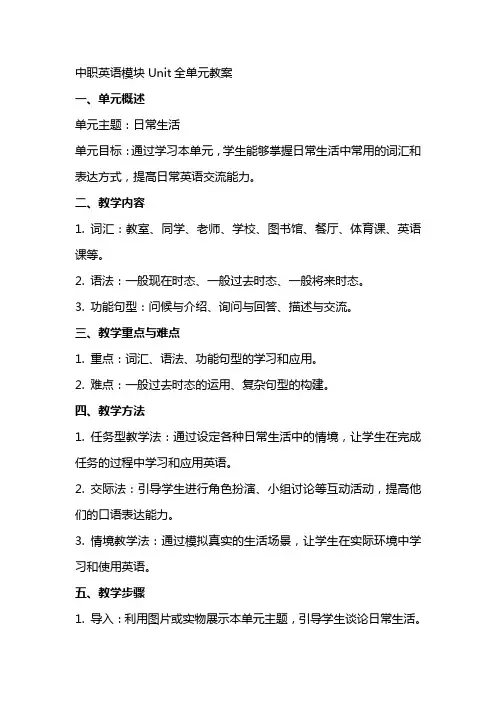
中职英语模块Unit全单元教案一、单元概述单元主题:日常生活单元目标:通过学习本单元,学生能够掌握日常生活中常用的词汇和表达方式,提高日常英语交流能力。
二、教学内容1. 词汇:教室、同学、老师、学校、图书馆、餐厅、体育课、英语课等。
2. 语法:一般现在时态、一般过去时态、一般将来时态。
3. 功能句型:问候与介绍、询问与回答、描述与交流。
三、教学重点与难点1. 重点:词汇、语法、功能句型的学习和应用。
2. 难点:一般过去时态的运用、复杂句型的构建。
四、教学方法1. 任务型教学法:通过设定各种日常生活中的情境,让学生在完成任务的过程中学习和应用英语。
2. 交际法:引导学生进行角色扮演、小组讨论等互动活动,提高他们的口语表达能力。
3. 情境教学法:通过模拟真实的生活场景,让学生在实际环境中学习和使用英语。
五、教学步骤1. 导入:利用图片或实物展示本单元主题,引导学生谈论日常生活。
2. 学习词汇:教授本单元所需掌握的词汇,让学生通过卡片游戏、词汇接龙等形式进行巩固。
3. 语法讲解:讲解一般现在时态、一般过去时态、一般将来时态的用法,并通过例句进行说明。
4. 功能句型练习:让学生进行角色扮演、小组讨论等活动,运用所学词汇和语法进行交流。
5. 课堂作业:布置相关的写作、翻译等作业,让学生课后巩固所学知识。
6. 总结与反馈:在课程结束时,对学生的学习情况进行总结和反馈,鼓励他们继续努力。
六、教学评价1. 评价方式:过程性评价与终结性评价相结合。
2. 评价内容:词汇掌握、语法运用、功能句型使用、口语表达、作业完成情况等。
3. 评价方法:课堂观察、学生互评、教师评价、作业批改等。
七、教学拓展1. 课外阅读:推荐学生阅读与日常生活相关的英语文章,提高他们的阅读能力。
2. 课外活动:组织英语角活动,让学生在实际环境中练习英语口语。
3. 网络资源:利用网络资源,为学生提供更多的学习资料和交流平台。
八、教学建议1. 针对不同学生的学习程度,适当调整教学难度和节奏。

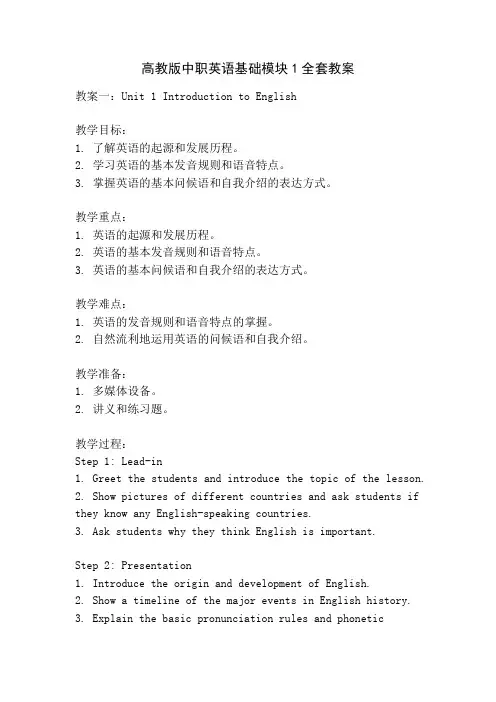
高教版中职英语基础模块1全套教案教案一:Unit 1 Introduction to English教学目标:1. 了解英语的起源和发展历程。
2. 学习英语的基本发音规则和语音特点。
3. 掌握英语的基本问候语和自我介绍的表达方式。
教学重点:1. 英语的起源和发展历程。
2. 英语的基本发音规则和语音特点。
3. 英语的基本问候语和自我介绍的表达方式。
教学难点:1. 英语的发音规则和语音特点的掌握。
2. 自然流利地运用英语的问候语和自我介绍。
教学准备:1. 多媒体设备。
2. 讲义和练习题。
教学过程:Step 1: Lead-in1. Greet the students and introduce the topic of the lesson.2. Show pictures of different countries and ask students if they know any English-speaking countries.3. Ask students why they think English is important.Step 2: Presentation1. Introduce the origin and development of English.2. Show a timeline of the major events in English history.3. Explain the basic pronunciation rules and phoneticfeatures of English.4. Use audio or video materials to demonstrate the correct pronunciation.Step 3: Practice1. Divide the class into pairs or small groups.2. Give students a list of common greetings and ask them to practice using them in different situations.3. Have students practice introducing themselves to each other using the phrases and sentences learned.Step 4: Consolidation1. Review the key points of the lesson, including theorigin and development of English, pronunciation rules, and greetings.2. Ask students to summarize what they have learned intheir own words.Step 5: Assessment1. Give students a short quiz to test their understanding of the lesson.2. Assign homework, such as writing a short paragraph about the importance of English or practicing greetings and self-introductions.教案二:Unit 2 Numbers and Time教学目标:1. 学习基本的数字和时间表达方式。
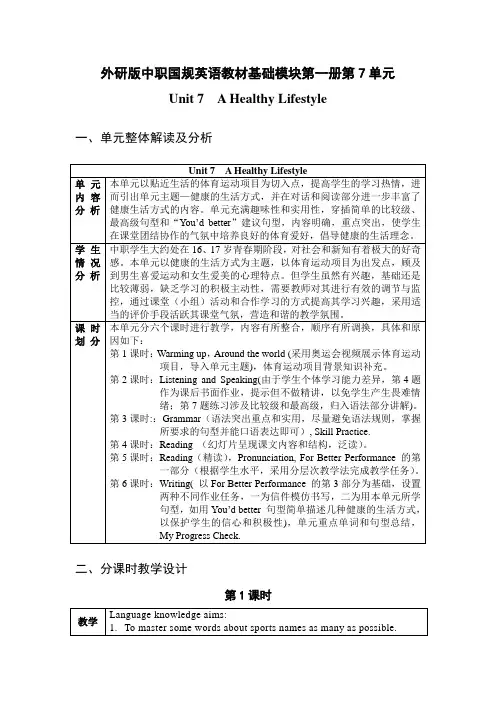
外研版中职国规英语教材基础模块第一册第7单元
Unit 7 A Healthy Lifestyle
一、单元整体解读及分析
二、分课时教学设计
第1课时
第2课时
第3课时
第4课时
第5课时
第6课时
作者简介:邓佳丁,2006年7月毕业于福建师范大学英语专业,文学学士,专业英语八级,,现任福建商贸学校外语教研室主任,承担基础英语、英语语法、英语听说、商务英语等课程的教学工作,曾于2018年12月获福建省中职学校外语教师教学课件、教案设计、说课比赛二等奖;于2018年11月获全国第二届中等职业学校外语教师教学设计比赛一等奖。
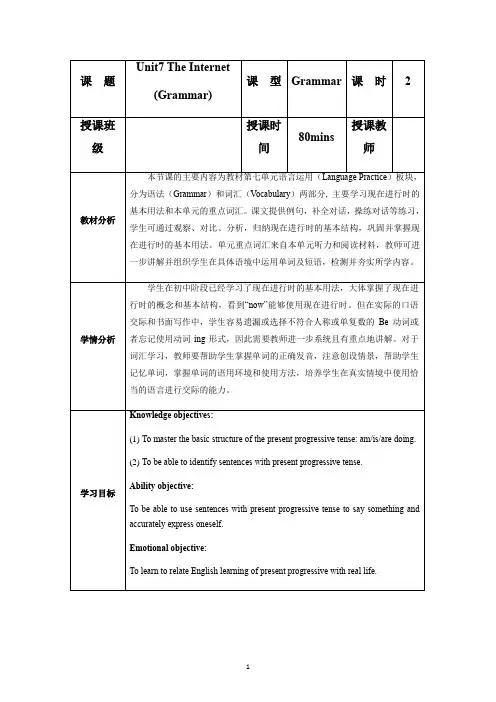
课题Unit7 The Internet(Grammar)课型Grammar课时2授课班级授课时间80mins授课教师教材分析本节课的主要内容为教材第七单元语言运用(Language Practice)板块,分为语法(Grammar)和词汇(V ocabulary)两部分, 主要学习现在进行时的基本用法和本单元的重点词汇。
课文提供例句,补全对话,操练对话等练习,学生可通过观察、对比、分析,归纳现在进行时的基本结构,巩固并掌握现在进行时的基本用法。
单元重点词汇来自本单元听力和阅读材料,教师可进一步讲解并组织学生在具体语境中运用单词及短语,检测并夯实所学内容。
学情分析学生在初中阶段已经学习了现在进行时的基本用法,大体掌握了现在进行时的概念和基本结构,看到“now”能够使用现在进行时。
但在实际的口语交际和书面写作中,学生容易遗漏或选择不符合人称或单复数的Be动词或者忘记使用动词ing形式,因此需要教师进一步系统且有重点地讲解。
对于词汇学习,教师要帮助学生掌握单词的正确发音,注意创设情景,帮助学生记忆单词,掌握单词的语用环境和使用方法,培养学生在真实情境中使用恰当的语言进行交际的能力。
学习目标Knowledge objectives:(1)To master the basic structure of the present progressive tense: am/is/are doing.(2)To be able to identify sentences with present progressive tense.Ability objective:To be able to use sentences with present progressive tense to say something and accurately express oneself.Emotional objective:To learn to relate English learning of present progressive with real life.学习重难点(1)To master the basic structure of the present progressive tense: am/is/are doing.(2)To be able to use sentences with present progressive tense to say something and accurately express oneself教学方法小组讨论法、任务教学法、情境教学法课前准备ppt课件,语音素材,视频与图片教学媒体PPT课件、多媒体设备、语音素材、拓展资源包等教学过程教学环节教师活动设计学生活动设计设计意图Step 1: Lead in Present a picture of eating the hamburger and askstudents:T: What is he doing?S: He is eating.Look at the pictureand answer thequestion: He iseating.通过图片的形式,自然引出现在完成时。
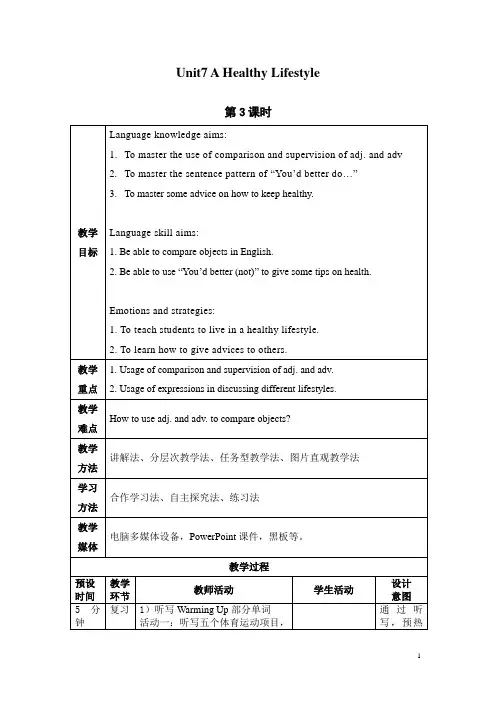
中职英语基础模块1 教学设计(教案、学案)Unit7第三课时Unit 7 Can I speakto Wang Yang?(第三课时教学设计)一、教材分析1、教学内容本课时系教材《英语1》(基础模块高教版)第七单元得第三课时reading and writing。
具体内容为:王洋发给美国网友Mike得邮件及围绕此邮件展开得相关练习。
本节课在整个单元中有非常重要得作用,它既就是对上节听说课得复习与巩固,又为本单元得任务----描述一个最喜爱得运动员做好阅读与写作得准备。
因为e-mail与本班同学得专业计算机有一定得关系,故学生对此内容比较熟悉与感兴趣。
这为教师安排与设计教学过程打下了较好得基础,对于e-mail 邮件格式家伙司可以不必花太多得时间去讲解。
2、教学重点、难点(1)教学重点学习王洋写给Mike得e-mail 邮件内容(2)教学难点通过阅读与学习邮件学生能对文中内容作简要得描述。
二、教学目标1、知识目标学生能掌握下列词与词组:volunteer, sell goods, drivea car,put upposters,hand out booklets, provide sth、for sb、, place flowers,be gladto do,more and more, look forward to2、能力目标通过阅读学生能理解e-mail得具体内容—担任奥运志愿者得工作,并通过具体活动完成课文相关得练习,从而提高阅读与写作能力3、情感目标鼓励学生通过e-mail得往来,加深彼此得了解与友谊三、教学步骤Step One Warm up 6’1、Teach new word “volunteer”Show a red cap of a volunteer、T: What’sthis?S:…T:If you wear this cap, whatare you?S:…、T:Doyouwork as an volunteer?S:…T:Whatkind of work doyou do as a volunteer?S: …、T:Here are somework,can you match?2、Match the phrases andthe picturesShow some pictures on the screen、They are about: sell goods, drivea car, put up p osters, hand out booklets, playvolleyball, play the piano and write e-mailWhen studentsare doing it, teacherasksthem to tell the Chinese meaning、设计意图:学校里有青年志愿者服务队,通过志愿者小红帽得展示来学习单词volunteer 学生会觉得印象比较深;通过图片对e-mail中得词组进行学习为课文学习做铺垫。
Unit 7 Can I speak to Wang Yang?Dialogue B I’m playing table tennisLearning objectives:1. Understand the sentences used to make a phone call.2. Master these sentence patterns.3. Make an own dialogue.Important points:Know how to make and answer a phone call.Difficult points:Students can remember all kinds of expressions for making a phone call.Teaching procedures:Step I. Warm up1. Make a duty report2. Review —— translate some sentences (competition)3.Check the answers——translationhold onmake a phone callall rightdo houseworkat the momentof courseStep II. Lead-inLook at some pictures,then describe them. Ask students “What are they doing?”Sara and Tang Hua are making a phone call in the last picture. What are they talking about? Please go into dialogue B.Step Ⅲ. Speaking1. Ask students to read the dialogue and answer the following questions:Q1: How many people are there in the dialogue?Three.Q2:What does Tang Hua want Sara to do ?Tang Hua wants Sara to play badminton with him.Q3:What is Sara doing?She is washing her clothes.2. Ask students to read the dialogue carefully and find out the sentences used to make a phone call.3. Translate the dialogue.4. Ask students to find out the key points and explain them.(1) May / Can I speak to Sara? Sara 在吗?(2) hold on 稍等(3) What’s up? 怎么了?与“What’s the matter? ”“What’s the problem?”意思相近(4) This is Tang Hua. 我是唐华。
中职英语模块Unit全单元教案一、单元概述单元主题:日常生活交流目标学生:中职一年级学生教学目标:1. 能够听懂并运用日常生活中的基本词汇进行交流。
2. 能够运用简单的句型进行日常问答。
3. 能够阅读并理解简单的日常生活对话。
二、教学内容1. 词汇:杯子、瓶子、饮料、食物等日常生活词汇。
2. 句型:介绍自己喜欢的饮料和食物,进行简单问答。
3. 对话:两人一组进行日常交流对话。
三、教学重点与难点重点:1. 日常生活词汇的掌握。
2. 简单句型的运用。
难点:1. 词汇的准确记忆。
2. 句型的灵活运用。
四、教学方法1. 情境教学法:通过设置日常生活情境,让学生在实际交流中学习并掌握词汇和句型。
2. 任务型教学法:通过两人一组进行日常交流对话,提高学生的实际应用能力。
五、教学步骤1. 导入:教师通过展示日常生活图片,引导学生说出相关词汇,为新课学习做好铺垫。
2. 新课内容:教师讲解新词汇和句型,让学生进行听力练习,理解并掌握句型。
3. 实践环节:学生两人一组进行日常交流对话,教师巡回指导并纠正发音。
4. 巩固环节:教师组织学生进行游戏或竞赛,巩固所学词汇和句型。
5. 作业布置:教师布置课后作业,要求学生复习所学内容,并尝试与同学进行实际交流。
六、教学评价1. 课堂参与度:观察学生在课堂上的积极参与情况,以及他们对课堂活动的兴趣。
2. 口语表达能力:评估学生在日常交流对话中的口语表达能力,包括发音、语调、语言流畅性等。
3. 作业完成情况:检查学生课后作业的完成质量,以评估他们对词汇和句型的掌握程度。
七、课后作业1. 复习所学词汇和句型,巩固记忆。
2. 与同学进行一次日常交流对话,尝试运用所学内容。
3. 选择一篇简单的日常生活对话,进行阅读理解练习。
八、课程拓展1. 组织学生进行角色扮演,模拟日常生活场景,提高他们的实际应用能力。
2. 开展英语角活动,让学生有机会与更多的同学进行英语交流。
九、教学反思教师在课后应对本节课的教学效果进行反思,分析学生的学习情况,找出教学中的不足之处,以便在今后的教学中进行改进。
中职英语模块Unit全单元教案一、单元概述单元主题:日常生活目标学生群体:中职一年级学生教学目标:1. 让学生掌握日常生活中的基本词汇和表达方式。
2. 提高学生的听说读写技能,使他们能够熟练运用英语进行日常交流。
3. 培养学生的跨文化交际意识,增强他们用英语进行沟通的能力。
二、教学内容1. 词汇:生活中常见的名词、动词和形容词,如:house, family, food, work, happy, sad等。
2. 语法:一般现在时和一般过去时的表达方式。
3. 功能句型:问候、介绍、询问和回答个人信息、表达喜好等。
4. 文化背景:了解和尊重不同国家的日常生活习惯。
三、教学方法1. 任务驱动法:通过完成实际生活中的任务,激发学生的学习兴趣和动力。
2. 情境教学法:创设真实的日常生活情境,让学生在实际环境中学习和使用英语。
3. 交际法:鼓励学生积极参与课堂互动,提高他们的交际能力。
四、教学步骤1. 热身(5分钟):通过歌曲、游戏等方式,引导学生进入英语学习氛围。
2. 呈现(10分钟):用图片、实物等展示本节课的主题,引入新词汇和句型。
3. 实践(15分钟):分组进行角色扮演,模拟日常生活场景,运用新学的词汇和句型进行交流。
4. 巩固(10分钟):通过练习题、小组讨论等方式,巩固所学内容。
5. 总结(5分钟):对本节课的内容进行简要回顾,强调重点和难点。
五、作业布置1. 抄写本节课学到的词汇和句型。
2. 结合所学内容,写一篇关于自己日常生活的短文。
3. 预习下一节课的内容。
六、教学评估1. 课堂参与度:观察学生在课堂活动中的参与情况,了解他们的学习兴趣和积极性。
2. 语言运用能力:通过角色扮演、小组讨论等环节,评估学生的听说读写技能。
3. 作业完成情况:检查学生作业的完成质量,了解他们对所学知识的掌握程度。
七、单元计划1. 第一课时:引入日常生活主题,学习基本词汇和句型。
2. 第二课时:练习一般现在时和一般过去时的表达方式。
1 / 14Unit 7Can I speak to Wang Yang? 教学内容:Unit 7: Lead in; Listening and Speaking; Reading and Writing; Language in use 语言知识目标:学生能够理解并运用正确的打电话用语,并正确使用现在进行时态表达正在进行的动作,了解部分与体育相关的词汇。
语言技能目标:听——学生能够听懂打电话用语。
说——学生能够使用正确的方式打电话。
读——学生能够读懂介绍正在进行的动作或行为的与体育相关的文章。
写——学生能够运用正在进行时态写出正确的句子。
学习策略:学生能够将动词词组与名词词组进行正确的搭配。
文化意识:学生能够了解英语中打电话的习惯用语与汉语的打电话用语的区别。
情感态度:学生能够了解和正确运用英语与他人通电话。
单元任务:学生就最喜欢的体育明星作报告。
Lesson One教学内容:Lead in; Listen and Speaking Dialogue A 教学目标:1知识目标:words and expressions; Making and answering a phone call 2能力目标:Understand talks about sports.Describe actions2 / 14教学重点:Understand an e-mail on sports games; Write a report on a famous player教学难点:Four-skill words and expressions教学方法:启发式,互动式文案大全教学工具:教科书,收音机德育要点:学生能够了解和正确运用英语与他人通电话。
教学步骤:Step One:Presentation教师活动:Look and match.看图,将下列北京奥运会的运动项目图标与项目名称搭配。
volleyballbaseball Step 2Lead in学生活动:Read and tick.选出每组中更适合用于打电话的语句。
(1)() A. Hello!() B. How do you do?(2)()A. Can I speak Ben Bush?() B. I want to talk to Ben Bush. (3) ()A. Who are you?()B. Who is that?(4) () A. I am Ben Bush.() B. This is Ben Bush speaking. (5) () A. Is that Ben Bush?() B. Are you Ben Bush? Step 3listening and speaking教师活动:Can I speak to Wang Yang?学生活动: Listen and choose.听录音,选择正确答案。
They will go to __________ restaurant.AYueguang3 / 14Listen and tick.再听录音,选择正确的表述。
The phone call is between __________.a. Tang Hua and her fatherb. Tang Hua and Wang Yangc. Tang Hua and Wang Yang's fatherListen and tick.再听录音,勾出正确的便条。
BMeiwei badmintonfootball table tennisbasketballswimming文案大全From: Tang HuaCome to school this afternoon to play basketball. From: Tang HuaCome to school this afternoon to play football. From: Tang HuaCome to school tomorrow to play football.Read and underline.阅读对话,用下画线标出打电话和接听电话的语句。
Wang Yang's mother: Hello!Ben: Hello! This is Ben. Can I speak to Wang Yang?WangYang'smother:Thisishismotherspeaking.WangYangisn'tinatthe moment. May I take a message?Ben:OK,thanks.Pleasetellhimtocometoschoolthisafternoon. I wantto play basketball with him.Wang Yang's mother: All right. I'll tell him.Ben: Thank you. Good-bye!Wang Yang's mother: You're welcome. Bye!师生活动:Explain the language points:重点词汇和句型This is Ben.我是Ben。
英语中打电话用this和that来表示“我是?”和“你是?”。
4 / 14Eg:Who's that?你是谁?Is that Wang Yang?你是王洋吗?This is his mother speaking.直译为“这是他的妈妈在说话。
”在打电话时意为“我是他的妈妈。
”He isn't in at the moment.他现在不在家。
in在这里意为“在家”。
May I take a message?可以捎个口信吗?take a message “捎口信”学生活动: Listen and repeat.跟读对话,学说选出的语句。
Step 5Sum(小结)板书设计:Unit 7 Can I speak to Wang Yang? 文案大全Wang Yang's mother: Hello!Ben: Hello! This is Ben. Can I speak to Wang Yang?WangYang'smother:Thisishismotherspeaking.WangYangisn'tinatthe moment. May I take a message?Ben:OK,thanks.Pleasetellhimtocometoschoolthisafternoon. I wantto play basketball with him.Wang Yang's mother: All right. I'll tell him.Ben: Thank you. Good-bye!Wang Yang's mother: You're welcome. Bye!Homework:(家庭作业)Recite the dialogue A. Feedback:(教学反馈)Lesson Two教学内容:Listen and Speaking Dialogue B 教学目标:5 / 141知识目标:words and expressions; Making and answering a phone call 2能力目标:Understand talks about sports.Describe actions教学重点:Understand an e-mail on sports games; Write a report on a famous player教学难点:Four-skill words and expressions教学方法:启发式,互动式教学工具:教科书,收音机德育要点:学生能够了解和正确运用英语与他人通电话。
文案大全教学步骤:Step One: PresentationActivity 1:Ask students to Think and answer.思考并回答下列问题。
Question 1: I'm playing table tennis.Step 2Listen学生活动: Look and choose.看图,选择动词的适当形式填空。
Ben __________ a phone call.A. makesB. is making Tang Hua__________ housework.A. doingB. is doingLi Xiaonian and Zhang Qing __________ badminton.A. are playingB. play Listen and judge.听录音,判断下列图片和表述是否正确。
() a. Ben is making a phone call with Sara. () b. Wang Yang is making a phone call with Sara. () c. Ben is doing housework.6 / 14() d. Sara is doing housework.() e. Ben and Sara are playing table tennis. () f. Ben and Wang Yang are playing table tennis.Read and underline.阅读对话,用下画线标出打电话和接听电话的语句。
Tang Hua: Hello! This is Tang Hua. May I speak to Sara? Sara's roommate: Hold on, please.A moment later.Sara: Hello! This is Sara speaking.Tang Hua: Hi, Sara. This is Tang Hua. What are you doing now? Sara: I'm washing my clothes. What's up?文案大全Tang Hua: I'm playing badminton with Xiaonian at school. Sara: Oh! I like playing badminton best. Tang Hua: Would you like to join us? Sara: Of course! I'll come soon!Tang Hua: Good! See you!教师活动:Explain some key points:May / Can I speak to Sara? Sara在吗?Hold on, please.请稍等。